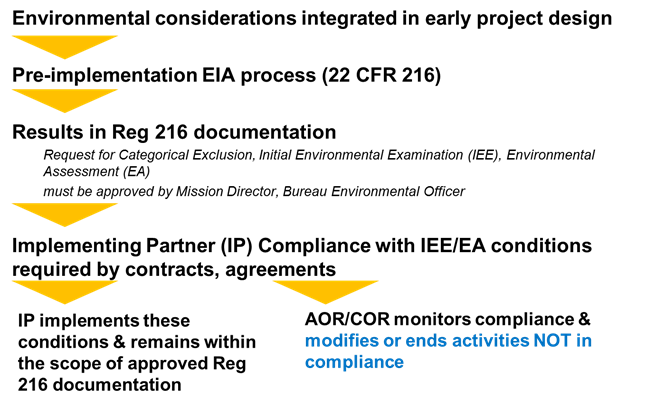USAID is required by court order, executive order, and statute to utilize an Environmental Impact Assessment (EIA) process to evaluate the potential impact of USAID’s activities on the environment prior to implementation. The agency must “fully take into account” environmental sustainability in designing and carrying out its development programs.
USAID fulfills these requirements through the Agency's environmental procedures. These consist of:
- Federal regulation (22 CFR 216), which defines USAID’s pre-implementation EIA process; and
- Mandatory operating policies set out in USAID’s Automated Directives System (ADS), which define implementation of this process and follow-through requirements during project implementation. (Visit the “laws, regulations and policies” page to access source documents.)
The purpose of the procedures is to assure that the potential adverse impacts of development activities on ecosystems, environmental resources, and human health and welfare are identified prior to implementation, that this information fully informs the decision of whether or not to proceed to implementation, and that activities are designed and implemented to minimize these impacts. In short, the procedures are a life of project process for achieving environmentally sound design and management (ESDM).
In summary, USAID’s environmental procedures require that:
- Environmental considerations are taken into account in activity planning/early design.
- Prior to implementation, all activities undergo a formal EIA process defined by 22 CFR 216. This process is documented in 22 CFR 216 documentation and must be duly approved by the Mission Director (or equivalent) and the Bureau Environmental Officer..
- Environmental mitigation and monitoring conditions resulting from this EIA process are written into procurement instruments (contracts, awards, cooperative agreements, etc.), implemented and monitored.
- Operating units must report annually on the environmental compliance status of each project in their portfolio.
- Environmental compliance documentation is maintained and used to actively manage implementation.
(Subtopics in this section, available via the navigation bar at left, provide more information about elements 2-5)

Resources
- Presentation: Life-of-Project Environmental Compliance for Environmentally Sound Design and Management. GEMS Training Presentation. Overviews life-of-project environmental compliance requirements and illustrates the value of these procedures with a number of graphic examples. PDF (7MB)
- USAID Environmental Procedures Briefing for Mission Staff. 7-page plain-text overview of life-of-project environmental compliance requirements and roles and responsibilities of various mission staff. Word (118 KB)